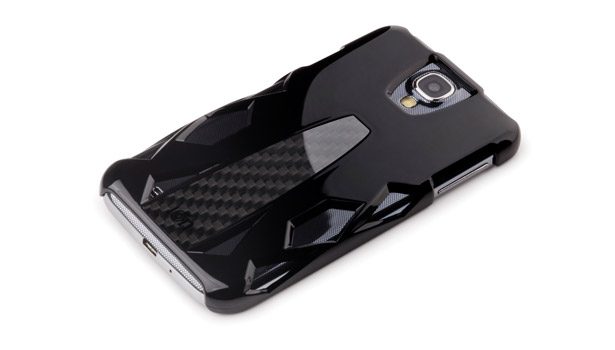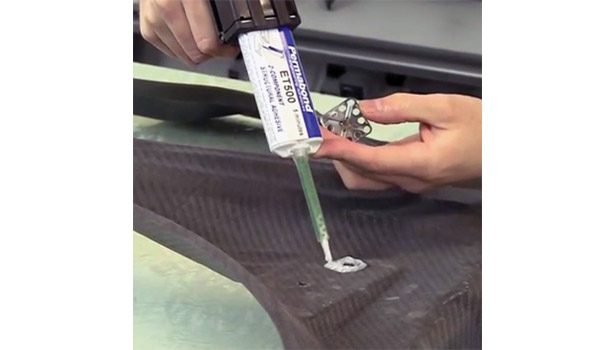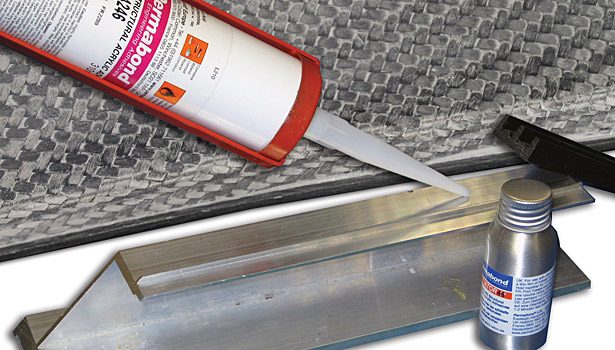Composite materials, including carbon fiber, are often preferred over conventional materials such as metal because they are lightweight, versatile and resilient.
| Jump to: |
Carbon fiber is increasingly preferred for its traditional composite features and benefits and—as the latest fashion trends show—its fantastic finished appearance. Composite materials can be used to make not only a catwalk, but designer accessories as well.
The use of composite materials is particularly prevalent in the aerospace and transportation market sector because composites offer high-strength performance while keeping component weight down, thereby enabling better fuel efficiency and improved performance. Adhesive bonding of these composites offers many benefits and is widely accepted.
Unlike mechanical fasteners, adhesives maintain the composite material’s structure by eliminating the need to drill holes or puncture the composite. An adhesive bond can unitize the two pieces so they will not rattle or vibrate independently, which leads to fatigue. Adhesives further contribute to weight reduction because they simply weigh less than mechanical fasteners. In addition, adhesives provide a seam-free, perfect aesthetic finish, so products can be color-matched to the substrate material.
Bonding Systems
Adhesive formulations chosen for composites in aerospace and transportation applications are diverse and application-specific, but some examples include methyl methacrylates, surface-activated methyl methacrylates, modified epoxies and modified silane (MS) polymers, and two-component urethanes.
Methyl Methacrylates
Methyl methacrylates offer very high bond strength and rapid strength development and are noted for their strength and durability in bonding fixtures, railings, nameplates, and antennae. They are often referred to as MMAs and are two-component, room-temperature-cure adhesives that can be dispensed through a static mix nozzle to avoid manual mixing.
Surface-Activated Methyl Methacrylates
Surface-activated methyl methacrylates provide the strength and process versatility of minimal set time needed to work in field applications, such as wire harness attachments within aircraft.
Modified Epoxies/MS Polymers
Modified epoxies and MS polymers provide the flexibility and low shrinkage needed to eliminate read-through in many thin panel applications for trucks, trailers, and planes. The high elongation and excellent peel strength provide joint toughness and durability. MS polymers are single-component, room-temperature-cure adhesives, while modified epoxies are two-component and cure more quickly than MS polymers.
Two-Component Urethanes
Two-component urethanes provide both strength and flexibility for large carbon fiber applications, such as car hoods. They can also be mixed through static mix nozzles.
Composite Advancements
Lightweight, high-performance composite formulations and processes are expanding along with the adhesives chosen to bond them. As this occurs, composites properties are increasingly sought after in many market segments. Medical appliances, devices and prosthetics, as well as sporting goods and sports equipment have all been improved by composites.
Many of the adhesives used in aerospace and transportation are successful in these applications, but other applications in these markets require effective bonding of the composite to a variety of substrates. Examples of adhesives systems for bonding composites in medical appliances and sports equipment include cyanoacrylates, two-component systems and epoxies.
Cyanoacrylates
Cyanoacrylates provide the ideal properties for quickly forming strong bonds between carbon fiber and foams/other padding on medical appliances. They are often called instant adhesives because many achieve handling strength in less than 10 seconds. High-performance grades feature high temperature resistance, low odor, and quick cure on acidic surfaces and are non-blooming.
Two-Component, No-Mix Systems
Two-component, no-mix acrylic and initiator provide structural bonds that fill and seal joints, making devices easier to clean and helping to prevent bacterial growth. Many of these systems are non-flammable and can reach handling strength in as little as 10 seconds.
Epoxies
Epoxies provide the ultimate bond performance of high shear, impact strength and environmental resistance needed in carbon fiber bike frames, golf clubs and other sporting equipment. Epoxies are available in one and two components. One-component epoxies are cured with heat, while two-component epoxies are cured at room temperature but can be heated to speed cure or enhance performance properties in some cases.
Composites in Fashion
The variety of designer accessories made with carbon fiber is growing: items from eyewear, key rings and handbags to mobile device cases and license plate
The variety of designer accessories made with carbon fiber is growing: items from eyewear, key rings and handbags to mobile device cases and license plate holders all use carbon fiber. |
holders all use carbon fiber. For example, UV-light-curable adhesives offer strong bonds and clear, aesthetically pleasing finishes. The fast processing also supports their use on clear windows in cases. Similarly, non-blooming and surface-insensitive cyanoacrylates are ideal for bonding carbon fiber (and many carbon fiber imitation materials) to other substrates, such as a metal money clip.
The progression of applications in the composites industry is the reverse of what occurred in the plastics industry. Initially, plastics were used on applications that required less structural integrity than the glass, wood or metal they were replacing. Over time, as plastics properties improved, plastic substrates were used in more robust applications. It made sense: “Let’s try this plastic on a handbag; then, if it works, maybe we can put it in an airplane.” Now the thought process is, “Well, composites work in airplanes—maybe we can make a purse?”
Final Thoughts
Like plastics, composites are diverse. An adhesive that performs well on one kind of composite may have minimal adhesion to another type of composite. Similarly, differences in performance requirements, joint designs or process needs may vary, indicating the need for a different adhesive.
As a result, adhesive suppliers will still want to review details about the substrates, surfaces, temperature and chemical resistance requirements, and stresses (peel, tensile, compression), as well as process requirements to ensure proper adhesive selection. As composite applications expand, adhesive formulators are continuously creating new products to stay abreast of the ever-changing demands from engineered designs that take advantage of the benefits of lowered weight, high strength and aesthetic appeal of carbon fiber and other composite materials.
For additional information, contact the author at (860) 379-9172 or laurie.gibbons@permabond.com, or visit www.permabond.com.



